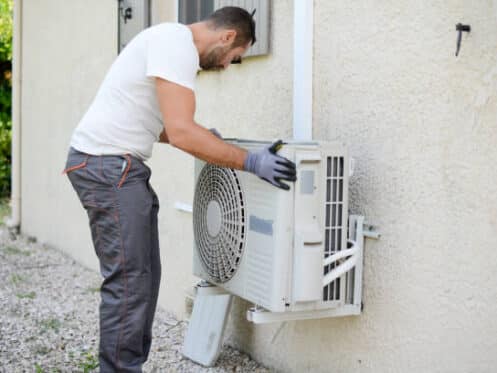Ductless mini-splits are marvels of modern technology that have revolutionized the way we cool and heat our living spaces. With their sleek design and incredible efficiency, these innovative systems offer homeowners a breath of fresh air. But how exactly do they work their magic? Keep reading as we delve into the fascinating inner workings of ductless mini-splits and discover the secret behind their exceptional performance.
How They Work
Ductless mini-split systems, also known as ductless air conditioners or heat pumps, are efficient cooling and heating systems that provide individualized temperature control for specific zones or rooms in a building. Unlike traditional central air conditioning systems, which use ductwork to distribute cooled or heated air throughout the entire building, ductless mini-split systems do not require ducts. The main components of a ductless mini-split system include an outdoor unit and one or more indoor units. The outdoor unit houses the compressor, condenser, and expansion valve, while the indoor unit contains the evaporator and blower fan. These components work together to cool or heat the targeted zone or room.
The indoor unit extracts warm air from the room through its grille or air intake to start the cooling process. The warm air passes over the evaporator coil, which contains a cold refrigerant. As the warm air comes into contact with the cold coil, heat energy is transferred from the air to the refrigerant, cooling the air in the process. The cooled air is then blown back into the room through the indoor unit’s outlet.
Meanwhile, the heated refrigerant, now in a gaseous state, is sent to the outdoor unit through copper tubing. The outdoor unit contains a compressor that pressurizes the refrigerant gas, raising its temperature. As the high-pressure, high-temperature gas flows through the condenser coil, it releases heat to the outside air. The refrigerant condenses back into a liquid state, and its temperature decreases.
The liquid refrigerant then travels back to the indoor unit through the copper tubing. At this point, an expansion valve in the indoor unit regulates the flow of refrigerant into the evaporator coil, creating a pressure drop. This pressure drop allows the refrigerant to evaporate and absorb heat from the indoor air, repeating the cooling cycle.
During the heating mode, the process is essentially reversed. The outdoor unit extracts heat from the outside air and transfers it indoors. The heated refrigerant flows through the indoor unit’s evaporator coil, where it releases heat energy to warm the air passing over it. The warmed air is then distributed into the room.
The Installation Process
The installation process of a ductless mini-split system involves several steps that ensure proper placement and functioning of the unit.
Site Survey
Before installing a ductless mini-split, a site survey is conducted to determine the most suitable location for the indoor and outdoor units. Factors such as room size, insulation, electrical requirements, and mounting options are considered during this process.
Indoor Unit Mounting
The indoor unit, also known as the evaporator or air handler, is mounted on an interior wall. A mounting bracket is typically used to secure the unit. The location should be selected carefully, ensuring it is near the center of the room and free from obstructions that could hinder airflow.
Hole Drilling
A small hole is drilled through the wall to connect the indoor and outdoor units. This hole allows the passage of refrigerant lines, electrical wiring, and the condensate drain line. The size of the hole depends on the diameter of these components.
Outdoor Unit Placement
The outdoor unit is positioned outside the building on a stable surface. It is usually placed on a concrete pad or mounted on brackets attached to an exterior wall. The location should have proper clearance for airflow and be protected from direct sunlight and excessive debris.
Refrigerant Line Connection
Refrigerant lines, including the liquid line and suction line, are routed through the drilled hole. The lines connect the indoor and outdoor units, enabling the flow of refrigerant. Proper insulation of these lines is crucial to prevent energy loss.
Electrical Wiring
Electrical wiring is installed to provide power to the indoor and outdoor units. This includes running cables from the electrical panel to the outdoor unit and from the outdoor unit to the indoor unit. Following local electrical codes and guidelines is essential to ensure safe and proper installation.
Condensate Drain Connection
A condensate drain line is connected to the indoor unit to remove the moisture generated during the cooling process. This line typically drains outside or into a designated drainpipe or drain pan. Proper slope and insulation of the drain line are essential to prevent leakage or condensate buildup.
Testing and Vacuuming
Once all the connections are made, the system is tested for proper functionality. To achieve optimal performance and efficiency, a vacuum pump is employed to eliminate air and moisture present in the refrigerant lines. This step is crucial to prevent damage to the system and maintain its longevity.
System Start-up and Configuration
After completing the installation and ensuring everything is functioning correctly, the system is powered on. The unit is configured according to the user’s preferences, including temperature settings, fan speeds, and other adjustable features.
Maintenance and Care
Professional maintenance of ductless mini-split systems is crucial to ensure their optimal performance and longevity. Engaging a qualified HVAC technician for these tasks is highly recommended because they possess the necessary expertise and tools. One important aspect of professional maintenance is regular filter cleaning or replacement. The filters in ductless mini-split units accumulate dust and debris over time, which can hinder airflow and reduce the system’s efficiency. A technician will inspect the filters and clean or replace them as needed, ensuring proper airflow and preventing strain on the system.
Additionally, a professional technician will thoroughly clean the indoor and outdoor units of the ductless mini-split system. Dust, dirt, and other particles can accumulate on the indoor unit’s evaporator coils and the outdoor unit’s condenser coils, impeding heat exchange and reducing efficiency. The technician will carefully clean these coils to maintain optimal performance. They will also check the condensate drain line for any blockages, as a clogged drain can lead to water leakage and potential damage.
Moreover, a professional maintenance service will include a comprehensive inspection of the electrical connections, refrigerant levels, and overall system performance. The technician will examine the electrical components, ensuring they are tight and secure, and inspect the refrigerant lines for any leaks or damage. If necessary, they will recharge the system with the appropriate refrigerant to ensure optimal cooling or heating capacity.
The technician will also assess the system’s overall performance by checking the thermostat settings, testing the heating and cooling modes, and verifying the functionality of any additional features or accessories. By addressing these aspects, a professional maintenance service helps to identify and resolve potential issues early on, preventing costly breakdowns and ensuring the system operates efficiently and reliably.
Get in Touch With Professionals Today!
Are you tired of dealing with heating issues, clogged drains, and faulty piping? Look no further than our professionals at Hunt’s Services! We are your go-to experts for all your heating, piping, and drain cleaning needs in Tacoma and the Puget Sound Area. With our skilled technicians and top-notch equipment, we guarantee efficient and reliable solutions to keep your home running smoothly. But that’s not all! We also offer a wide range of electrical services to meet your every need. Call us at Hunt’s Services today to schedule an appointment.




